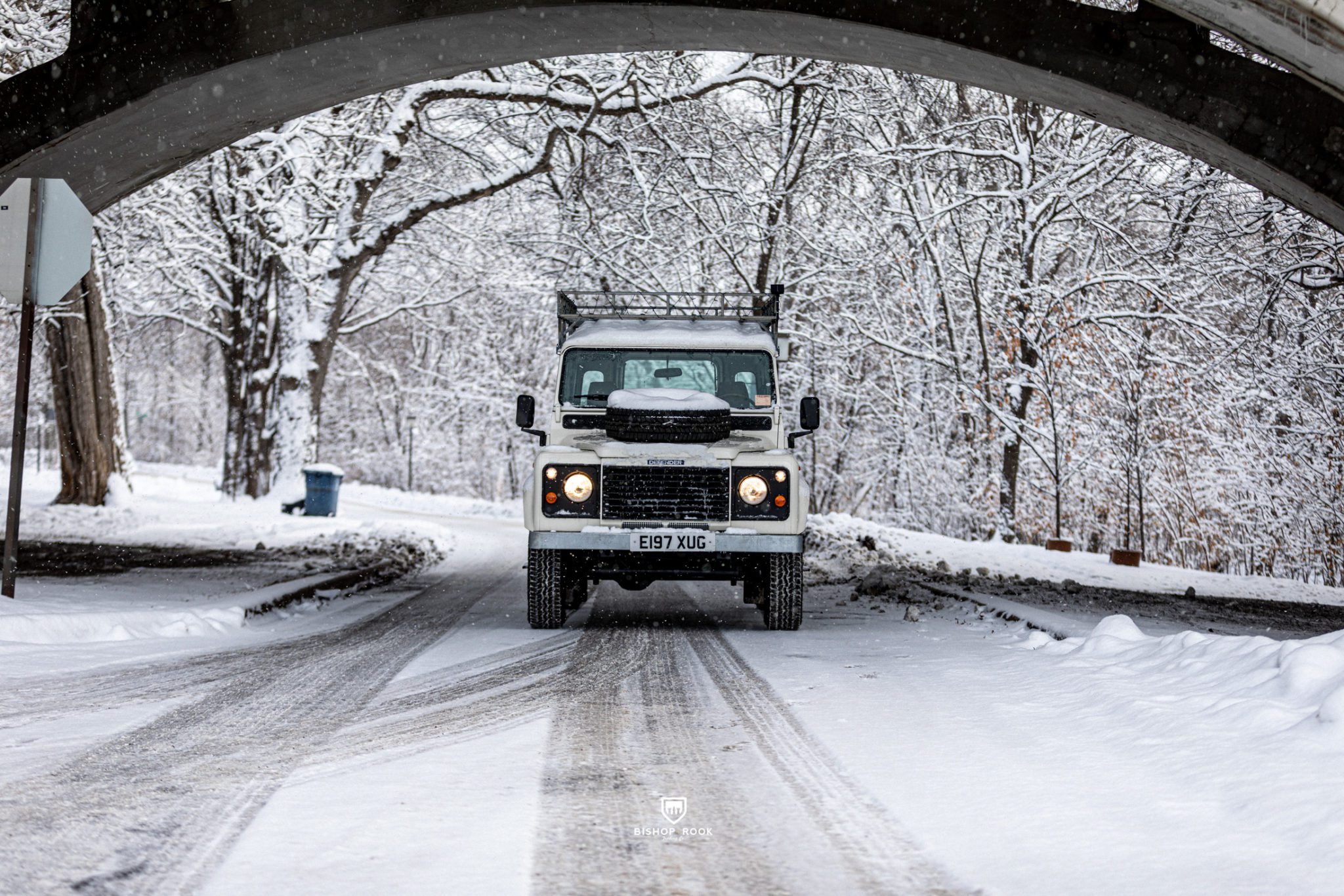The Difference Between a Budget Defender and a Refreshed Defender is Smaller Than You Think.
Setting a Budget For Your Land Rover Defender Adoption
We would wager that most of you reading this blog post do not have a blank check to begin your entry into Land Rover Defender ownership. It’s likely you’ve seen Defenders priced from $10,000 to $250,000 around the world, and you’re wondering why there is such a vast price difference between the low-end and high-end. There’s a very good reason. And that’s what we will get to in a moment. But first …
Nobody Wants to Pay Too Much for a Land Rover Defender
The first question people ask when they walk into the showroom for the first time is: “How much do these cost?” The answer is always an awkward, “well, that depends.” Ultimately it comes down to the final level of build or restoration a person is looking for. And that comes down to budget. Truth is, we don’t like asking people for a budget when they come in to talk to us about a Defender adoption or even our custom-build service – it feels creepy and salesy.
But it’s a crucial question to ask.
When we ask what type of budget the customer would like to stick to … we don’t do so because we want to see how much money they’re willing to spend, but rather to see what level they what to be at when buying a vintage Land Rover.
It’s really important to us that you feel like you get a great car for a great price. And our goal is always to help you work within your budget.
A couple of years ago, we wrote The Unicorn Hunt guide as a way to help people learn about the basics of Land Rover Defender adoption and what they should consider during the early stages. We also publish and update a simple Pricing Guide as a means to show people what their baseline budget should be. The purpose of these two guides is to help you pay for only what you want and not extras you will never need – or that don’t fit your lifestyle.
Owning a Defender is fun. Making the decision to spend money on such a unique vehicle can be stressful. This guide is designed to help you get the best vehicle for your investment.
Beware of Cosmetically Beautiful Mechanical Nightmares
We see a lot of tarted-up Land Rover Defenders hitting the US market, with many of them dressed up simply to pass along a mechanical nightmare to an unsuspecting American buyer. There is a trend of UK and other European sellers popping up on eBay and Facebook Marketplace advertising these vehicles.
If someone has advertised an “Export Eligible Defender,” that’s a pretty good tip that their focus is on selling to people they will never experience a face-to-face encounter. Use that information however you wish.
We recently had to save several people from these purchases – including several guys trying to flip them in their driveway as a hobby or a little extra cash. They thought they bought them from what appeared to be reputable UK businesses, which in reality were shell companies that pop up every couple of years, creating a nice back story of being in the business for years. They’re only selling crappy trucks under that trade name for a year or two and then move on after the internet forums uncover their unscrupulous business tactics.
Cosmetic fixes are cheap – mechanical and structural repairs take time and money. Learning the difference between the two will save you a lot of heartaches. If you’ve been researching Defenders for long enough, you will start to spot these types of vehicles pretty easily.
The truth is that anyone can import a car – very few can build a great Defender.
Who To Buy From
If you’ve read the guides we posted above, you’ll realize that anyone can import a Defender – even though the cost savings may be minimal – with great risk. Researching an already imported Defender can be very confusing if you’re just getting started. You’ll see prices from $25,000 to $250,000. The big question is, why such a vast difference? Who should I buy from? How do I find the right company to trust?
The simple answer is that building a mechanically and cosmetically perfect Defender takes a lot of time and money. On the high end, you will get a completely new vehicle – with every nut and bolt replaced and a modern drive train. On the lower end, you will find 25-year-old trucks in various stages of disrepair. Looking at who’s selling the Defender will give you some enlightening insight into their motivations.
We might be a little biased in some of our analysis, but here are some of the sellers you will find while researching your Defender purchase:
Loving Owners – These folks have owned the Defender for years, and now, for a reason other than their love of the vehicle, they have to part with their precious family member. Average ownership time: Long
Accidental Owners – A Defender isn’t for everyone. Some people fall in love with the “idea” of a Defender more than the practicality. When this happens, the owners typically try to get out of their investment quickly. Sometimes they bought something that got them in over their heads; other times, it’s just not a good lifestyle fit. Average ownership time: 6-18 months
Car Flippers – Someone decided that the market was good for Defenders, so they thought they could make a few bucks buying and selling them. They may import them directly or find them in the wild. A lot of the UK sellers above fall in this category. They’re basically used car dealers – either individuals or organizations. They are what they are. Average ownership time: 4-6 weeks.
Amateur Importers (Enthusiasts) – Several reputable guys in the US market import a few Defenders each year, drive the, love them, fix them, but ultimately put them up for sale so they can get their next project. For the most part, these guys are perfectly fine to buy from. Many have learned how to source a solid Defender they personally enjoy or maybe even picked up a bit of mechanical knowledge over the years to help repair neglected trucks. We started this way. Average ownership time: 4-12 months (repeated cycle).
Amateur Importers (Profiteers) – The other group of amateurs generally cause us the most anxiety. They are buying 2-3 Defenders at a time from the above-mentioned UK shops. They see only money. They want to spend as little as possible preparing the vehicles for sale. They will cover up rust, hide mechanical issues, or, often, know nothing about the Defender they are selling. They probably don’t have any mechanical tools but have learned how to take good photos (or use the photos from the terrible shop they bought them from).
If you’re sensing some tension about this group, you’re right. This group dumps crappy Defenders on the market for too high of prices, selling trucks with new carpet that covers rusty floors. They paint rusty exhausts silver and call it new. They put in a new interior but failed to fix a failing turbo. Average ownership: as quickly as they can dump their crappy trucks (sorry … we get mad when people don’t respect the Defender or take advantage of potential buyers).
Brokers – A couple of companies/guys/brokers on the market represent European builders. They will offer to import or build a Defender for you in a similar way that we do at Bishop+Rook. The difference is that they may or may not have an operational mechanical facility of their own. The Defenders they sell are generally fine, although sometimes a little bit expensive. Most of these guys will focus on cosmetic details such as interiors, wheels, light bars, Apple CarPlay, and paint. Few will discuss motors, suspension, brakes, or other mechanical features. We’re indifferent on this group, with the exception of some of the trucks coming from Turkey – some of those are simply garish nightmares of bad design taste. Average ownership: 2-3 months – depending on how overpriced they are.
There is one particular guy who has created a niche doing this, which would be fine, but he’s charging in excess of $300,000 for some of his “builds” that are simply creations done by a variety of other workshops in the UK that he represents as his own. He doesn’t own the workshop, the teams don’t work for him, and he’s just charging too much money. There, we said it….
Preservationists + Builders – Bishop+Rook falls in the last two categories – even though we started much smaller. We expanded our services because we realized the importance of mechanical stewardship of classic vehicles. We hand-select our inventory from around the world and offer both preservations of vehicles and custom builds. Folks like us respect the Defender as a unique vehicle that can provide joy and adventure. There aren’t many of us in this category, unfortunately. The best way to spot someone in this category is to ask this question: “Which Defender is yours?” If they’re like us, the answer will always be, “it depends on the day … all of them if I can.” Average ownership: Depends. As many might not be “for sale.”
Custom Builders – Companies like ECD, Arkonik, Twisted, The Land Rovers, Cool n Vintage, and others help push the boundaries of Defender builds. They are the pioneers in many categories of development – including motor swaps, electric vehicles, and custom interiors. They are the nut-and-bolt restoration folks, not because they feel this is critical but because their clientele demands it. I would also likely demand something special and unique if I were spending between $250,000 and $350,000 USD. Average ownership: they build trucks that last a lifetime but probably can’t afford their own products.
The Importance of Trust and Confidence
Trust and confidence are the two most important factors in deciding where to buy your Defender. Can I trust this person? Do they seem to be honest? If something goes wrong, will they fix it? Will they tell me what’s wrong with the truck if it’s not a complete build? Am I confident they have the ability to build the truck I’m looking for? Is there a place where I can take my truck back if I run into issues? Do they have a good history of happy customers?
We started Bishop+Rook because we were passionate about vintage cars – especially unique and boxy Land Rovers. It would make us happy if we got to do this for the rest of our lives. We’re big enough to support pretty much any build, but we also value personal connections and the ability to keep our overhead costs low, so we can pass those savings on to our customers.
Example Pricing Tiers for Defenders
The below references are for RHD and LHD Defenders. We do about half and half, but anyone with budget limitations should always consider a RHD truck first – you end up with a much better vehicle for the price.
Left Hand Drive (LHD) trucks can sometimes have a 25-35% premium due to demand, market conditions, shipping, etc. We do a quarterly pricing assessment on pricing and publish it here.
QUICK GUIDE: How does Bishop+Rook price your Defenders?
In this guide, we do discuss lower-level Defenders – a few of which we offer to the market. It’s not that they’re not available, it’s just that we typically don’t like putting sub-standard Defenders into the marketplace unless we’re 100% transparent that they are project vehicles only. Our Jerry Can pricing guide starts with 1-Jerry Can and goes to 5-Jerry cans. The below Tier system starts with our 3-Jerry Can Defenders. I know, confusing, but hopefully, it will make sense when you’re finished reading.



The Entry-Level Defender Conundrum (Tier I Defender)
$25,000 – $39,000 Defenders (RHD) +20% for LHD
One of our foundational principles is this: Mechanics First. Our build approach ensures each Defender is reliable and adventure-ready from day one. If something is sold on a project truck, we will let you know the issues to look for and address along the way. If you ask us to build you a truck (at any level of the build budget), we will ensure that it will be properly sorted and ready for the road. The analysis below goes for the Defenders we offer in this category and many others on the market. For the most part, these rules and prices tend to be universal.
With this knowledge, we’ve discovered one simple thing:
The difference between a $25,000 Defender and a $35,000 Defender is when you plan on spending the $10,000 to make it mechanically fit for the road.
Any Defender on the market in that “budget” or “value” price range should be cautiously approached. For some, it may be a matter of minor issues such as tyres, old batteries, brakes, fuel systems, and scrappy interiors. For others, there may be more costly hidden problems: rusted bulkheads, rotted rear cross members, rusted doors, worn suspension components, leaky turbochargers, or smokey engines.
There’s always a reason someone is selling their defender – in this budget range, you should probably ask this question. If it’s a European truck, they will sometimes fail their annual inspection, and people dump them into foreign markets.
Here are a few guiding questions for this category:
- How long have they owned it?
- What is the history?
- Are there items that are clearly not right?
- What mechanical work or maintenance has been done?
- What kind of shop, garage, or tools does the seller have?
We’ll attempt to work through a neglected maintenance cost scenario below, skip ahead if you’re bored already.




The Mid-Level Defender Nirvana (Tier II Defender)
$40,000 – $65,000 Defenders +20% for LHD
A Defender that has been properly sorted will give you a lot of joy and happiness. If you end up in this category, you should spend virtually zero time thinking, “am I going to make it if I take the Defender?” Even though your Defender will be 25+ years old, it should be just as reliable as when it left the factory. Given the longevity of Defenders around the world, you should feel confident in its mechanical abilities to get you from point to point on a daily basis.
For us, we probably spend between 150 and 300 hours getting a truck to this point of reliability. We cover all the base components: brakes, fuel, cooling, ignition, electrical, and suspension. We preserve what’s in good condition and replace what’s worn and tired. Parts are readily available and relatively affordable. Any garage mechanic could do this work, but we’ve noticed that in the first couple of years of Defender ownership, it’s much more fun to drive than a wrench.
A lot of specialist knowledge is needed to go through this first major round of refresh, while anyone can do general care and upkeep with a good set of tools and a little curious patience.
Better Than Factory Defender (Tier III Defender)
$75,000 – $105,000+ Defenders +20% for LHD
We believe Land Rover got it right the first time, so when we approach a frame-off restoration, we try to get it back to the way it left the factory. We take every part of the body off and completely rebuild the motor, gearbox, and transfer case. Both axles are rebuilt, and all new components are used to replace them.
This tier has a lot of room for creative customization and comfort. This is the area where we go beyond the simple utility of the factory Defender and start to tweak it for modern life. Sometimes it’s the simplicity of adding a charging port, while most times, it includes extensive sound mitigation methods, comfort packages, air conditioning, and adjusted suspension for comfort and style.
When we take a Defender apart, it gives us the freedom to fix everything that could be wrong or could go wrong on the vehicle. When we have access to the chassis, we can ensure it’s fully refurbished. When the motor is out, we can rebuild every component. When we paint it with the panels off, not a single bit of old paint, corrosion, or rust will remain.
When we’re finished, you’re presented with a one-of-one car that is not only designed for you but will last at least another 25 years. This category is suited for those with adventure in mind who understand the importance of investing in a timeless classic. While this might not be an attainable budget range for many (at least early on), it will give you a vehicle that has an overall low operating cost (as annual upkeep becomes no more than a modern car).
For us, or anyone else, we spend between 400 and 1550 hours building a truck to this specification.
The Cost Associated with a Budget Land Rover Defender
Let’s assume you set aside $25,000, and you want a Land Rover Defender 110. You’ve always wanted one and finally reached the stage where it makes sense for your lifestyle. You’ve looked all over, watched eBay for months, looked on Craigslist, and even some European and UK websites selling cars. You see them all over the board and really want to stick to the low end of your budget.
Based on the hundreds of cars we look at each year (which we use as the base for each build restoration), here are the items that are nearly universally neglected on lower-end trucks. Our estimates are estimates. Use these as a guide only.
Wheels + Tyres – They’re almost always weather cracked and aged out. Because most UK drivers don’t drive a lot – especially what they believe is a pretty agricultural driving experience, few Defenders cover more than a couple of thousand miles a year. If it’s been off the road for years, that only adds to the age. Don’t judge a tyre by its appearance; a 15-year-old tyre can look very good in photos but could be very bad on an American roadway.
What to Budget:
$180 – $260 – Per Tyre
$125 – $299 – Per Wheel (if needed)
Total: $1,525 – $2,795
Brakes + Suspension – Let’s assume the brakes need to be done because it’s been driven, parked, driven, parked, etc. The rotors are rusted and grooved, and someone sold the car right before they needed to do any maintenance. Reproduction parts can be fairly affordable, but if you take it to a local shop, they’ll likely use genuine Land Rover parts at retail prices. Depending on the condition (rust, broken brackets, busted lines), we estimate a full brake job to take a couple of days of shop time on a typical “fresh from the farm” Defender.
Shop Rates: $125 – $190 hour
Hour Range: 6 – 18 hours
Parts Cost: $200 – $1,200
Total: $1,000 – $2,500 +/-
Heating and Cooling System – Many Defenders come from warmer climates or at least ones that don’t generally freeze. That means most of their cooling systems are topped off with regular tap water at some point in their late life. That means most radiator components start to corrode and calcify internally – reducing efficiency and causing overheating. A water pump, radiator, and heater core would be the basic package to start with.
Shop Rates: $125 – $190 per hour
Hour Range: 8 – 20 hours
Parts Cost: $400 – $1,500
Total: $1,300 – $3,000 +/-
Smoking Engine + Low Power – Hunting down the source of a low-power or smoking engine can require both a degree in mechanics and philosophy. One never really knows why a Defender smokes. Some culprits are valve seals, piston rings, turbo seals, injector pumps, or even the oil collector. Sometimes it’s simple, sometimes, you never find the cause, and you either learn to live with it or do an engine rebuild.
Shop Rates: $125 – $190 per hour
Hour Range: A Great Mystery
Parts Cost: Who Knows
Total: How much is your first child worth? The second?
Final Thoughts
We wrote this guide based on our experience of buying and restoring old Defenders. We also based this guide on some of the things we’ve seen come into our shop from people who have purchased trucks from these third-party sellers we’ve seen above. It’s not meant to scare you but rather help you see the price difference between a budget defender and a properly sorted one. On the lower end, expect some things to go wrong. On the high end, make sure the shop takes care of all the mechanical components first and isn’t just focused on the “bespoke leather trim” they’ve purchased from an off-the-shelf vendor.











